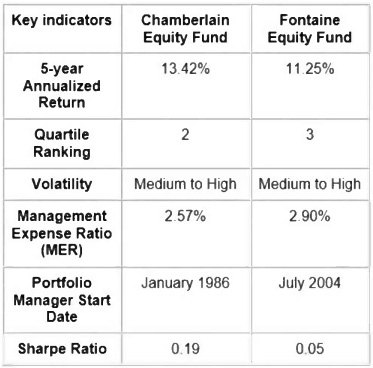IFSE Institute CIFC - Canadian Investment Funds Course Exam
You have been researching Canadian equity mutual funds for a new client. You come across the following information.

What can you conclude from this information?
For what reason do different entities have securities created and sold?
What areas are addressed in the Client Relationship Model (CRM) regulation?
Sujay contributes 3% of his $60,000 salary to his employer’s defined contribution pension plan. His employer contributes the same amount to the plan. How will this affect his registered retirement savings plan (RRSP) contribution room for the year?
One of your clients, Rakesh, had a portfolio composed of 60% ABC Equity Fund and 40% ABC Bond Fund. Since equities were performing much better than fixed income, he had increased his holdings in ABC Equity Fund to 70% and had reduced his holding in ABC Bond Fund to 30% of his portfolio.
After benefitting the growth in his ABC Equity Fund for over 2 years, Rakesh is uncomfortable with this heavy exposure to equity funds and decides to rebalance his portfolio back to 60% of ABC Equity Fund and 40% of ABC Bond Fund.
He instructs you to switch 10% of the portfolio from the ABC Equity Fund to the ABC Bond Fund.
Which of the following statements is CORRECT?
Based on your discussions with your client Sierra, you believe an asset allocation of 30% fixed income and 70% equities will help her achieve her long-term goals. What type of asset allocation strategy are you implementing?
Which of the following best describes how a target date fund works?
One of your clients, Sheldon, is 65 years old. He has $30,000 to invest. He has a low risk profile, and an investment objective of receiving regular income. He has a time horizon of 5 years.
Based on Sheldon's risk profile and investment objective, which of the following investment recommendations is MOST appropriate for Sheldon?
Danny is a Dealing Representative for Everbright Investments. He met with his client Adele, who has $1,000,000 to invest. During their meeting Danny determines that Adele has a high-risk profile. In addition, he learns that she has an excellent understanding of equities and how volatile they can be. Danny is considering recommending growth funds specifically, and making a recommendation from the following investment options:

Based on the information provided, which mutual fund should Danny recommend?
Gregory is a conservative investor who wants to hold a portfolio of equity securities that would fall less than the overall market in a downturn.
Which of the following portfolios would you advise Gregory to invest in?



